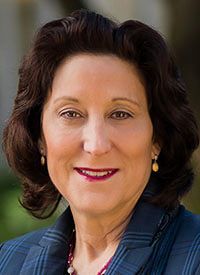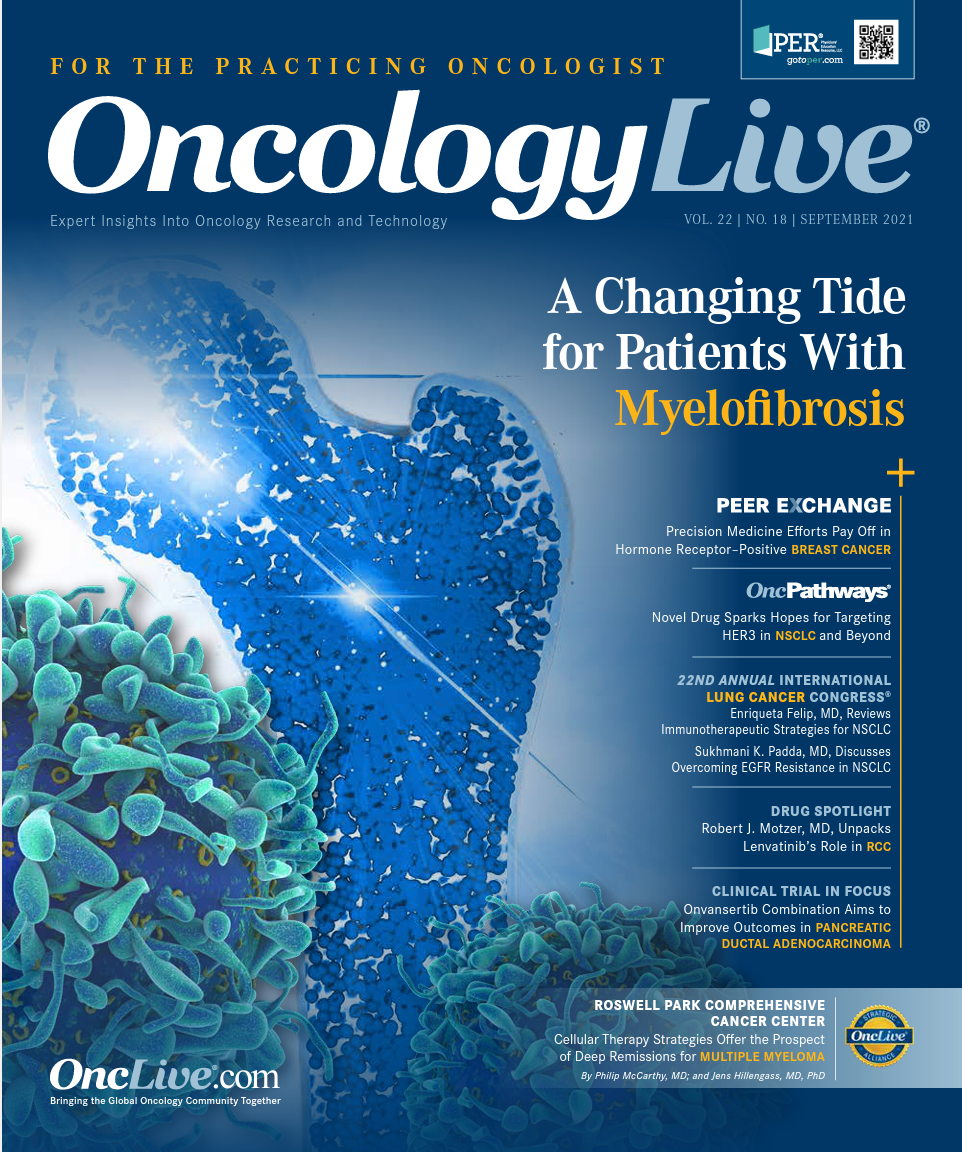Publication
Article
Oncology Live®
Precision Medicine Paves the Way for Advances in Hormone Receptor–Positive Breast Cancer
Author(s):
Early-stage hormone receptor–positive, HER2-negative breast cancer is generally associated with a good prognosis; however, even with early intervention, some patients recur and have reduced survival.
Aditya Bardia, MD, MPH

Early-stage hormone receptor–positive, HER2-negative breast cancer is generally associated with a good prognosis; however, even with early intervention, some patients recur and have reduced survival. This has led to the development of a variety of molecular profiling tools to determine patients’ risk of recurrence, including distant metastases, and the search for better adjuvant treatments to prevent such events in these patients.
During a recent OncLive Peer Exchange®, a panel of breast cancer experts discussed data surrounding a variety of genomic assays that are being used and investigated toward individualized treatment planning, enabling escalation of treatment in at-risk patients and de-escalation strategies for those unlikely to benefit. They also discussed some of the latest data for CDK4/6 inhibitors in the adjuvant treatment setting. “In the next 5 years, we’re going to see more precision medicine in breast cancer,” Aditya Bardia, MD, MPH, said. “It’ll be about the right drug for the right patient based on under-standing tumor biology at the right time,” he added, noting that breast cancer is “the poster child for precision medicine” because treatment is already heavily influenced by molecular markers.
Unraveling Molecular Markers
The panelists discussed various efforts that are being made to better understand the biology of early-stage breast cancer, focusing on 3 frequently used genomic assays: Oncotype DX, MammaPrint, and the Breast Cancer Index (BCI) (Table 11-7).
Table 1. Genomic Assays for Patients With Early-Stage Breast Cancer1-7

Oncotype DX
Oncotype DX, a genomic test for patients with early-stage invasive breast cancer, measures the expression of 21 genes—including 16 cancer-related genes and 5 reference genes—to determine a patient’s recurrence score (RS). The score is then used to classify the tumor as low, intermediate, or high risk.1
Investigators of the SWOG S1007 RxPONDER trial (NCT01272037) evaluated the benefit of chemotherapy in women with hormone receptor–positive, HER2-negative breast cancer and 1 to 3 positive lymph nodes.2 Results of the study showed that postmenopausal women with a 21-gene recurrence score (RS) no greater than 25 per the Oncotype DX assay derived no benefit from the addition of chemotherapy to endocrine therapy, whereas premenopausal women meeting the same criteria had an approximate 45% relative risk reduction in invasive disease-free survival (iDFS) events when chemotherapy was added to endocrine therapy.
“Recent data that have come out from RxPONDER help us understand that patients who are premenopausal and have node-positive disease, pending further subset analyses of the RxPONDER trial, really everyone who is premenopausal should be considered for chemotherapy at this time,” Nicholas McAndrew, MD, MSCE, said. Of note, at the time of the analysis, only 54% of the protocol-specified events had been recorded.2 The study plans to follow patients for 15 years.
Nicholas P. McAndrew, MD, MSCE

“Prior to the data from RxPONDER, I tended to use the Oncotype DX assay for my node-negative patients, and I would consider using the MammaPrint for my node-positive patients with 3 or fewer nodes. However, in the setting of RxPONDER, there are good data that are predictive for both node-negative and node-positive disease with the use of Oncotype,” McAndrew said.
Although several panelists agreed that the default position based on the RxPONDER data should be to give chemotherapy to all premenopausal women with early-stage hormone receptor–positive, HER2-negative, node-positive disease, Hope S. Rugo, MD, FASCO, cautioned against this one-size fits-all approach, especially since the data are still in their infancy. “Giving a patient who has 1 positive node and a recurrence score of 2 chemotherapy, including an anthracycline and a taxane, doesn’t really make sense to me,” she said, emphasizing the importance of considering the long-term toxicities of chemotherapy. “With anthracyclines, the long-term serious consequences are low, but even a low risk isn’t worth it if you don’t need it,” she said.
Hope S. Rugo, MD, FASCO

MammaPrint
MammaPrint is a genomic test that analyzes the activity of 70 of the most important genes associated with breast cancer recurrence to determine relapse risk for women with early-stage breast cancer, based on their tumor profile.3 At the 2021 American Society of Clinical Oncology (ASCO) Annual Meeting, data for a relatively recent subclassification, dubbed ultralow risk, were presented.4
The analysis included patients who had a score of at least 0.355 on MammaPrint, a cutoff that had been previously identified and found to be associated with an “exceedingly low risk” of death from breast cancer after surgery alone in women who were followed for 2 decades.5 The results confirmed these findings, showing women with ultralow-risk disease who participated in the randomized phase 3 MINDACT trial (NCT00433589) to have a breast cancer–specific survival greater than 99%, regardless of their clinical risk status. Further, the results also showed an 8-year distant metastasis-free interval of 95% to 98%.4 Based on the findings, the study investigators concluded that “patients with ultralow-risk tumors could be candidates for further de-escalation of treatment,” which might help prevent overtreatment and reduce the risk of treatment-related adverse events.
Though it appears that patients classified as ultralow risk may have a very indolent cancer, Rugo warned that this should not be interpreted to mean that these patients do not require any systemic treatment. “We should use endocrine therapy [for these patients], but it may be that it doesn’t matter which endocrine therapy you use…but we know they don’t need chemotherapy. That is absolutely for sure,” she said.
Breast Cancer Index
BCI analyzes the activity of 11 genes that can indicate how likely the cancer will recur 5 to 10 years after diagnosis. The results of the assay provide a recurrence percentage as well as an answer as to whether the patient is likely to benefit from an additional 5 years of hormone therapy, which is indicated as yes or no.6,7 During 2021 ASCO, data from the National Surgical Adjuvant Breast and Bowel Project (NSABP) B-42 study (NCT00382070) were presented, which examined the effect of the BCI HOXB13/IL17BR ratio (BCI-H/I) in predicting benefit with extended aromatase inhibitor therapy with letrozole.8 The BCI-H/I ratio has been previously shown to be predictive of benefit to endocrine and extended endocrine therapy.
“If [a patient had a] high-risk score and you gave extended-duration aromatase inhibitor therapy, [as you might expect,] you saw the benefit later…because you get a carryover from your first 5 years for the first few years [post treatment],” Rugo said, adding that using the ratio “suggests that you may be differentiating the group of patients who benefit from longer-term aromatase inhibitor therapy, but that we’re going to need even longer follow-up of the NSABP trial to really understand that true benefit.”
The panelists agreed that while the genomic tests are important, they provide a static snapshot and more dynamic testing is needed. “Mutation profiling is only a first step…We should aggressively pursue full profiling of tumors at the time of diagnosis, with serial profiling as the patient proceeds through therapy, which hopefully, with incorporation of machine learning approaches, will help us develop decision support systems that can help busy oncologists make these decisions in a more comprehensive way using the totality of data,” Dejan Juric, MD, said.
Dejan Juric, MD

CDK4/6 Inhibitors
Despite early-stage hormone receptor–positive, HER2-negative breast cancer being associated with the best outcomes among all breast cancer subtypes, an estimated one-third of patients will relapse,9 which has led to a search for novel treatment approaches. Because CDK4/6 inhibitors have changed the treatment paradigm for metastatic hormone receptor–positive, HER2-negative breast cancer, with benefit observed in both progression-free survival (PFS) and overall survival (OS), there has been a lot of excitement about using them in the adjuvant setting. However, recent data have been mixed, Andrew D. Seidman, MD, explained. “PALLAS [data] were a bit of a disappointment in terms of palbociclib’s [Ibrance] effect in the adjuvant setting, [but] we’ve seen some encouraging results with abemaciclib [Verzenio],” he said. Seidman noted that data are not yet available for ribociclib (Kisqali), which is being examined in the NATALEE trial (NCT03701334), but that the study recently completed accrual.10
Andrew D. Seidman, MD

Palbociclib
The international phase 3 PALLAS trial (NCT02513394) randomly assigned 5760 patients with early-stage hormone receptor–positive, HER2-negative breast cancer to receive palbociclib plus endocrine therapy (n = 2882) or endocrine therapy alone (n = 2877).11 After a median follow-up of 23.7 months, a similar percentage of patients in each group had iDFS events; 5.9% in the palbociclib arm and 6.2% in the control arm. The 3-year iDFS was also similar between arms (88.2% vs 88.5%, respectively). Similar to the PALLAS trial, the PENELOPE-B trial (NCT01864746) did not show benefit with the addition of palbociclib to endocrine therapy.12 The study assessed the combination in patients with hormone receptor–positive, HER2-negative breast cancer and residual invasive disease after neoadjuvant chemotherapy.
Although the PALLA and PENELOPE-B findings were anticlimactic compared with the practice-changing data observed in the metastatic setting, Bardia explained that there are several key differences in these settings that may help account for the disparity. First, he said that the mechanism of action may play a role, as these agents work by blocking cell proliferation. “If a patient has metastatic disease in general, that’s a cell that’s proliferating. But in the adjuvant setting, particularly for ER [estrogen receptor]-positive disease, cells could be dormant…if the cells are dormant, CDK4/6 inhibitors are unlikely to have an impact,” Bardia said.
Another factor may be treatment duration. “In the metastatic setting, we don’t stop the CDK4/6 after 6 months, 1 year, or 1.5 years. We continue until disease progression,” he said. In contrast, the trials in patients with early-stage disease had set durations. “What we saw from PENELOPE was that when you’re using the CDK4/6 inhibitors, it can put the brakes on, but when you stop the CDK4/6 inhibitor, the cells maybe started proliferating again and you start seeing the recurrences,” he said. Subsequently, Bardia explained it will be important to identify biomarkers to guide treatment duration.
Finally, he said adherence is another key challenge in the adjuvant setting. “In the metastatic setting in general, patients continue therapies unless there is severe toxicity, but in the adjuvant setting, we have patients who discontinue aromatase inhibitors and now you’re adding a second agent. We saw in PALLAS that about 50% of patients discontinued an aromatase inhibitor plus palbociclib. If you don’t use the drug, you’re not going to see the benefit,” he said.
Abemaciclib
In a subanalysis of the phase 3 monarchE trial (NCT03155997), adjuvant abemaciclib showed benefit in patients with high-risk, early-stage, hormone receptor–positive, HER2-negative breast cancer previously treated with neoadjuvant chemotherapy.13 Patients were deemed high risk if they had at least 4 positive lymph nodes or 1 to 3 positive lymph nodes and either grade 3 disease, tumor size measuring at least 5 cm, or central Ki-67 at least 20%. Among the 2056 patients who received neoadjuvant chemotherapy in monarchE, 1025 received adjuvant abemaciclib and endocrine therapy and 1031 received adjuvant endocrine therapy alone. Abemaciclib plus endocrine therapy showed benefit, with improvements in iDFS vs endocrine therapy alone, with an HR of 0.614 (95% CI, 0.473-0.797) and a 2-year iDFS rate of 87.2% vs 80.6%, respectively. The addition of abemaciclib to endocrine therapy also improved distant relapse-free survival (DRFS), with an HR of 0.609 (95% CI, 0.459-0.809) and a 2-year DRFS rate of 89.5% and 82.8%, respectively.
“What is special about the monarchE trial is that they successfully identified a group of patients who seemed to have higher recurrence risk in the first 5 years,” Rugo said. “If we can identify those patients in practice, we should consider use [of abemaciclib].” She explained that a higher lymph node burden is a clearer path to using adjuvant abemaciclib, but that decision-making remains uncertain in patients with no more than 3 positive lymph nodes. “By Ki-67 alone, an inherently unstable marker, we don’t know. Patients who have a lot of disease have such a high risk. We probably aren’t doing them a big disservice—no long-term toxicities—so we would consider it now while waiting for longer-term data,” she said.
References
- About the Oncotype DX Breast Recurrence Score test. oncotype IQ. Accessed August 21, 2021. https://www.oncotypeiq.com/en-US/breast-cancer/healthcare-professionals/oncotype-dx-breast-recurrence-score/about-the-test
- Kalinsky K, Barlow WE, Meric-Bernstam F, et al. First results from a phase III randomized clinical trial of standard adjuvant endocrine therapy (ET) +/- chemotherapy (CT) in patients (pts) with 1-3 positive nodes, hormone receptor-positive (HR+) and HER2-negative (HER2-) breast cancer (BC) with recurrence score (RS) < 25: SWOG S1007 (RxPonder). Clin Cancer Res. 2021;81(suppl 4):GS3-00. doi:10.1158/1538-7445.SABCS20-GS3-00
- The molecular profile to define and defeat her unique cancer. Agendia Precision Oncology. Accessed August 24, 2021. https://agendia.com/mammaprint/
- Lopes Cordozo J, Drukker C, Schmidt M, et al. Outcome of patients with an ultralow risk 70-gene signature in the MINDACT trial. J Clin Oncol. 2021;39(suppl 15):500. doi:10.1200/JCO.2021.39.15_suppl.500
- Esserman LJ, Yau C, Thompson CK, et al. Use of molecular tools to identify patients with indolent breast cancers with ultralow risk over 2 decades. JAMA Oncol. 2017;3(11):1503-1510. Published correction appears in JAMA Oncol. 2017;3(11):1589.
- Explore the report. Biotheranostics, Inc. Accessed August 23, 2021. https://breastcancerindex.com/explore-the-report-providers
- Block EJ, Kroep JR, Meershoek-Klein Kranenbard E, et al; IDEAL Study Group. Optimal duration of extended adjuvant endocrine therapy for early breast cancer; results of the IDEAL trial (BOOG 2006-05). J Natl Cancer Inst. 2018;110(1). doi:10.1093/jnci/djx134
- Mamounas EP, Bandos H, Rastogi P, et al. Breast Cancer Index (BCI) and prediction of benefit from extended aromatase inhibitor (AI) therapy (tx) in HR+ breast cancer: NRG oncology/NSABP B-42. J Clin Oncol. 2021;39(suppl 15):501. doi:10.1200/JCO.2021.39.15_suppl.501
- Xu B, Fan Y. CDK4/6 inhibition in early-stage breast cancer: how far is it from becoming standard of care? Lancet Oncol. 2021;22(2):159-160. doi:10.1016/S1470-2045(20)30757-9
- Slamon DJ, Fasching PA, Patel R, et al. NATALEE: phase III study of ribociclib (RIBO) + endocrine therapy (ET) as adjuvant treatment in hormone receptor–positive (HR+), human epidermal growth factor receptor 2–negative (HER2–) early breast cancer (EBC). J Clin Oncol. 2019;37(suppl 15):TPS597. doi:10.1200/JCO.2019.37.15_suppl.TPS597
- Mayer EL, Dueck AC, Martin M, et al. Palbociclib with adjuvant endocrine therapy in early breast cancer (PALLAS): interim analysis of a multicentre, open-label, randomised, phase 3 study. Lancet Oncol. 2021;22(2):212-222. doi:10.1016/S1470-2045(20)30642-2
- Loibl S, Marmé F, Martin M, et al. Palbociclib for residual high-risk invasive HR-positive and HER2-negative early breast cancer—the Penelope-B trial. J Clin Oncol. 2021;39(14):1518-1530. doi:10.1200/JCO.20.03639
- Martin M, Hegg R, Kim SB, et al. Abemaciclib combined with adjuvant endocrine therapy in patients with high risk early breast cancer who received neoadjuvant chemotherapy (NAC). J Clin Oncol. 2021;39(suppl 15):517. doi:10.1200/JCO.2021.39.15_suppl.517























%20(2)%201-Recovered-Recovered-Recovered-Recovered-Recovered-Recovered-Recovered-Recovered-Recovered-Recovered-Recovered-Recovered-Recovered-Recovered-Recovered-Recovered-Recovered.jpg?fit=crop&auto=format)
%20(2)%201-Recovered-Recovered-Recovered-Recovered-Recovered-Recovered-Recovered-Recovered-Recovered-Recovered-Recovered-Recovered-Recovered-Recovered-Recovered-Recovered-Recovered.jpg?fit=crop&auto=format)
